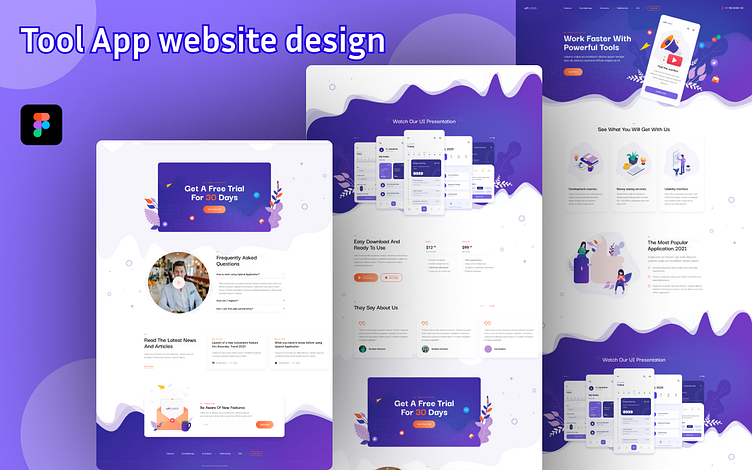Tool App Website Design
Don’t forget to ❤️ Press “L” to support the shot
Stay tuned for our updates at Behance
Stay tuned to our updates at LinkedIn
Fiverr account: Click Here
3. Feature Showcase:
Highlight the main features of your tools prominently on the website's landing page.
Use visuals, icons, or animations to demonstrate how the tools work and their capabilities.
4. Responsive Design:
Ensure the website is responsive and looks good on various devices (desktops, tablets, mobiles).
Optimize for touchscreens and smaller screens for ease of use.
5. Clear Call-to-Actions (CTAs):
Have clear CTAs guiding users to sign up, download, or access the tools. Make these buttons or links prominent and easily accessible.
6. Visual Appeal:
Use a visually appealing design that aligns with your brand and the tool's purpose.
Use high-quality images, graphics, and animations where appropriate.
7. Navigation:
Keep navigation simple and intuitive. Use clear menus, breadcrumbs, or search options for easy exploration of different tools or features.
8. Speed and Performance:
Optimize website loading speed to ensure a seamless user experience.
Test the website's performance and make necessary optimizations for faster loading times.
9. Support and Documentation:
Provide easily accessible FAQs, tutorials, or documentation for users to learn about the tools and troubleshoot any issues they might encounter.
10. Testimonials and Social Proof:
Showcase user testimonials or case studies to build trust and credibility.
Integrate social media feeds or share buttons to encourage user engagement and sharing.
11. Subscription or Membership Option:
Consider offering a subscription model or membership plan for premium features.
Clearly communicate the benefits of upgrading or subscribing.
12. Security Measures:
Implement security protocols to protect user data and ensure a safe browsing experience.
13. Feedback Mechanism:
Include feedback forms or contact options for users to provide suggestions or report issues.
14. Continuous Improvement:
Collect user feedback and analytics to continuously improve the website and tools based on user insights.
Remember, the design of a tool website should not only attract users but also provide a seamless experience and add value by effectively showcasing the capabilities and benefits of the tools you offer.
3. Feature Showcase:
Highlight the main features of your tools prominently on the website's landing page.
Use visuals, icons, or animations to demonstrate how the tools work and their capabilities.
4. Responsive Design:
Ensure the website is responsive and looks good on various devices (desktops, tablets, mobiles).
Optimize for touchscreens and smaller screens for ease of use.
5. Clear Call-to-Actions (CTAs):
Have clear CTAs guiding users to sign up, download, or access the tools. Make these buttons or links prominent and easily accessible.
6. Visual Appeal:
Use a visually appealing design that aligns with your brand and the tool's purpose.
Use high-quality images, graphics, and animations where appropriate.
7. Navigation:
Keep navigation simple and intuitive. Use clear menus, breadcrumbs, or search options for easy exploration of different tools or features.
8. Speed and Performance:
Optimize website loading speed to ensure a seamless user experience.
Test the website's performance and make necessary optimizations for faster loading times.
9. Support and Documentation:
Provide easily accessible FAQs, tutorials, or documentation for users to learn about the tools and troubleshoot any issues they might encounter.
10. Testimonials and Social Proof:
Showcase user testimonials or case studies to build trust and credibility.
Integrate social media feeds or share buttons to encourage user engagement and sharing.
11. Subscription or Membership Option:
Consider offering a subscription model or membership plan for premium features.
Clearly communicate the benefits of upgrading or subscribing.
12. Security Measures:
Implement security protocols to protect user data and ensure a safe browsing experience.
13. Feedback Mechanism:
Include feedback forms or contact options for users to provide suggestions or report issues.
14. Continuous Improvement:
Collect user feedback and analytics to continuously improve the website and tools based on user insights.
Remember, the design of a tool website should not only attract users but also provide a seamless experience and add value by effectively showcasing the capabilities and benefits of the tools you offer.
3. Feature Showcase:
Highlight the main features of your tools prominently on the website's landing page.
Use visuals, icons, or animations to demonstrate how the tools work and their capabilities.
4. Responsive Design:
Ensure the website is responsive and looks good on various devices (desktops, tablets, mobiles).
Optimize for touchscreens and smaller screens for ease of use.
5. Clear Call-to-Actions (CTAs):
Have clear CTAs guiding users to sign up, download, or access the tools. Make these buttons or links prominent and easily accessible.
6. Visual Appeal:
Use a visually appealing design that aligns with your brand and the tool's purpose.
Use high-quality images, graphics, and animations where appropriate.
7. Navigation:
Keep navigation simple and intuitive. Use clear menus, breadcrumbs, or search options for easy exploration of different tools or features.
8. Speed and Performance:
Optimize website loading speed to ensure a seamless user experience.
Test the website's performance and make necessary optimizations for faster loading times.
9. Support and Documentation:
Provide easily accessible FAQs, tutorials, or documentation for users to learn about the tools and troubleshoot any issues they might encounter.
10. Testimonials and Social Proof:
Showcase user testimonials or case studies to build trust and credibility.
Integrate social media feeds or share buttons to encourage user engagement and sharing.
11. Subscription or Membership Option:
Consider offering a subscription model or membership plan for premium features.
Clearly communicate the benefits of upgrading or subscribing.
12. Security Measures:
Implement security protocols to protect user data and ensure a safe browsing experience.
13. Feedback Mechanism:
Include feedback forms or contact options for users to provide suggestions or report issues.
14. Continuous Improvement:
Collect user feedback and analytics to continuously improve the website and tools based on user insights.
Remember, the design of a tool website should not only attract users but also provide a seamless experience and add value by effectively showcasing the capabilities and benefits of the tools you offer.
